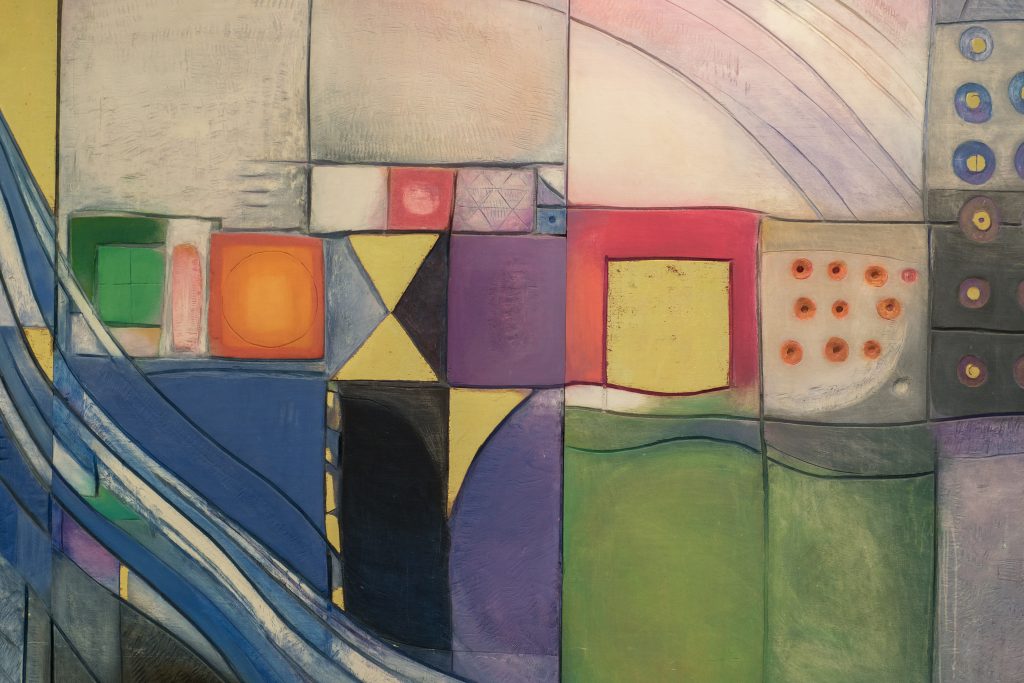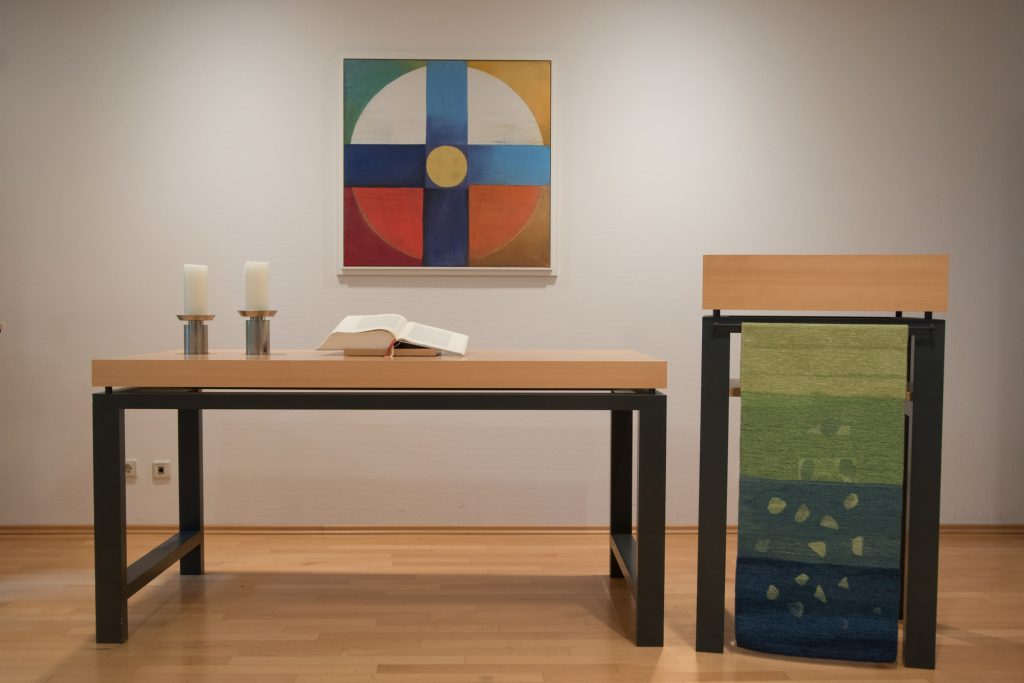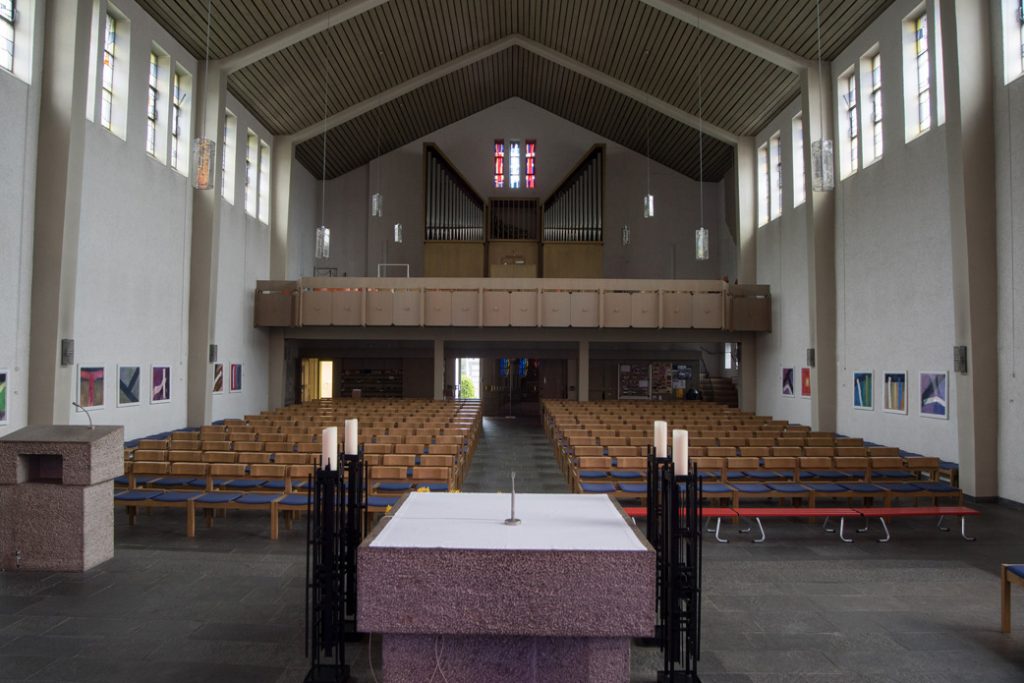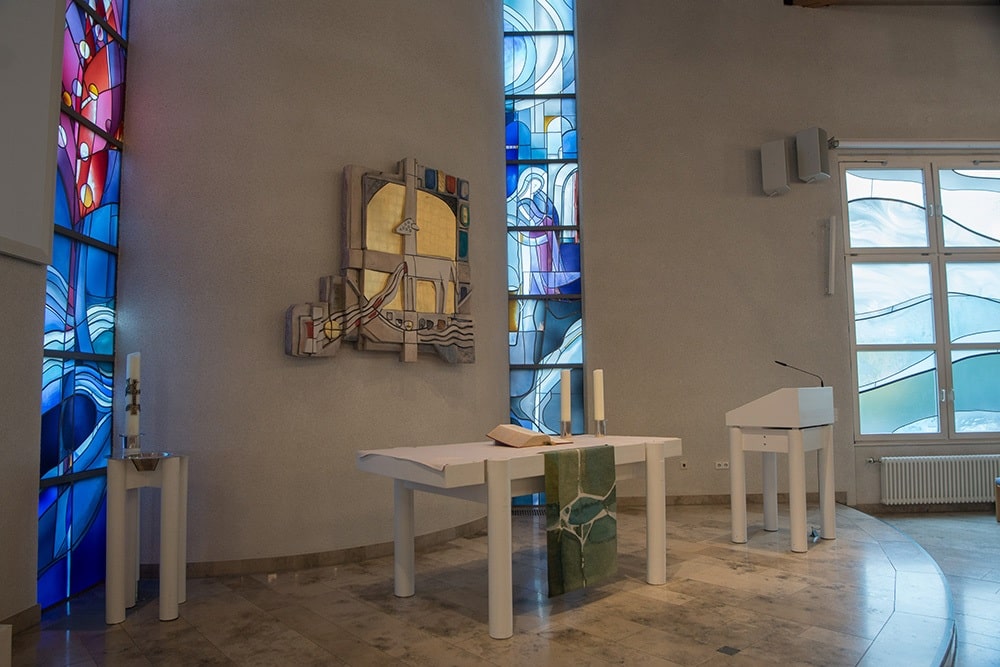
The water in the Pond of Bethesda in Jerusalem, after which the Agaplesion Hospital is named, was known as healing water. The Gospel of John says that an angel descended into the pool and […] moved the water. Whoever went in first after the water had been moved was healed, no matter what disease he was afflicted with. (Joh 5,4 EU)
The movement of water can either be imagined as a miracle or be based on mechanical forces that have been used for thousands of years to distribute water into reservoirs via lifting devices. Andreas Felger’s River of Life shows a gush that brightly and clearly releases its purifying, liberating, in the best case healing energy. The water falls down three metres in height, crosses the fifteen-square-metre picture surface diagonally and seems to continue flowing beyond the edge of the picture.
It crosses broken rock structures, the natural space from which the cisterns were once wrested. Above it stand emblematic buildings, the dwellings of man, recognisable by their right angles. In the upper third of the picture, gold leaf and the white, blue and violet of the sky speak of vastness and openness; in the lower third, abysses open up and close in the darkness.
One could experience this bas-relief with its many indentations as a tactile image, the material would speak to the fingertips through its unevenness. Irregular is also the sequence of forms that put human orders as grown structures into the picture.
Smooth and soft is only the moving water, which as a flow of life can also expand the horizon: To understand one’s own life as part of a constantly changing whole, a challenging and at the same time liberating idea.
Author: Marvin Altner

Table, lectern, parament and picture – Andreas Felger regularly designs this ensemble of objects for churches and devotional spaces.
The design features of the objects are adapted to the respective spaces, be they historic church buildings with their complex interior architecture or churches and devotional rooms that have been built since the post-war period and are often spartanly furnished. Neutral room conditions also create resonances; they can come quite close to the atmosphere in museum exhibition rooms.
In Ludwigsburg’s Haus am Salon, the maple table and desk tops, made according to Felger’s designs, harmonise with the parquet flooring, while the dark anthracite-coloured frames provide striking frames. Softened by the materiality of the parament and the fine colour transitions in the oil painting, however, they strike the viewer’s eye and mind more gently.
The bright and clearly structured overall design is also reflected in the altarpiece. Its geometric composition is reminiscent of mathematical problems such as the squaring of the circle. That Felger is not concerned with transcendent numbers and mathematics, however, becomes apparent in the design detail. The square of the base is divided into nine smaller rectangles and the cross and circle are inscribed in this grid.
The artist, however, chooses narrower crossbars, draws the circle in slightly so that it does not touch the edge of the picture, and creates a colour concept that implements the title of the work quite literally:
The heaviness of the cross is overcome.
From the bottom left to the top right, the colours brighten, detach themselves from the geometric severity of the composition and lose their intensity and heaviness. In accordance with the resurrection as the meaning and goal of Christian passion, the transitions from red and brown to green, blue and white can also be interpreted and experienced in contemplation as a reference to redemption and transcendence.
Author: Marvin Altner

PARISH CENTRE: 2 WOODCUTS: I am the vine, I am the bread, 1995, Woodprint on paper, each 104 x 80 cm
Anyone who enters the wide, bright room of the St. Boniface Church in Asperg is at first physically uplifted by its towering glass windows and can breathe more freely. When the churchgoer then looks at Andreas Felger’s Stations of the Cross, which are hung at eye level and measure 70 x 70 cm, he comes face to face with them – also in a figurative sense.
The Way of the Cross of the Christian Son of God tells the story of physical and spiritual suffering of a human being. The spiritual independence of Jesus from the martyrdom of his humiliated body is only selectively addressed in this narrative (8th station, Jesus speaks to the weeping women).
Anselm Grün has therefore interpreted Andreas Felger’s watercolours of the Stations of the Cross in the sense of directly addressing the viewer: The sufferings, which show Jesus not sublime but humanly at the mercy of others, give us the possibility of identification and call on us to recreate the exemplary pain in a carthartic process in our own lives.
The visual language of Felger’s Way of the Cross is abstract, and yet the content of the biblical story and the sequence of concrete actions are depicted.
The example of Christ falling three times under the cross (3rd, 7th, 9th station) makes this particularly clear, because they are variations on a theme. Man and cross appear in the form of two bars, light, almost white and somewhat smaller for the man and dark, almost black and somewhat larger for the cross.
Diagonal positions of these beams visualise the respective course of events, the dynamics of the fall and the relationships between an overpowering cross and a bent (but not broken) human being. The three steps of these representations show how eloquently Felger knows how to use the bar forms: the 3rd station shows the fall in a still open constellation, the 7th emphasises the hopelessness of submission in the enclosed and strongly curved white bar and the 9th station anticipates in its dynamics the breathing out of life from the body, which happens in the 12th.
The craftsmanship of the pictorial material also makes concrete references to the Stations of the Cross. Andreas Felger uses the watercolour technique for an unusual condensation of colours, heightens the effect of the picture with contrasts, scratches out colour and thus emphasises the materiality of the paper as a picture carrier. On closer inspection, the painted paper, the body of the picture, proves to be a material artistically processed in the finest gradations, which suffers injuries and mediates between composition and destruction.
The stone in front of the tomb, which takes up the entire centre of the picture in Felger’s 14th sheet (intersected only by the fine whitish line referring to the person buried), concludes his Stations of the Cross. When the viewer’s gaze leaves this stone and turns to the room, the whole nave seems to speak of the meaning of the Way of the Cross, of redemption and exaltation through the Resurrection.
Author: Marvin Altner

Andreas Felger’s group of works in the Versöhnungskirche in Schorndorf combines the materials glass, wood and fabric into a thematic unity that revolves around the concept of reconciliation. At the centre is the Lamb of God as a sign of Christ’s resurrection and the forgiveness of human sins: “Behold the Lamb of God who takes away the sin of the world.” (Jn 1:29; 1:36 EU).
On the left, the stained glass window shines with the tree of life, to which Adam and Eve were denied access when they were cast out of paradise. In the New Testament, the hope of eternal life, the fulfilment of the plan of salvation for man, could only be experienced again through the death of Christ on the cross. On the right appears a scene from the parable of the merciful father and the prodigal son. The Father’s love for the returned son is also captured in an image of forgiveness, the cancellation of guilt through grace.
The special feature of the Schorndorf ensemble is that Andreas Felger combines these familiar but at the same time multi-layered Christian themes compositionally in such a way that they dynamically merge into one another or, in another word, flow into one another. The flow of blood of the lamb, the water at the foot of the tree of paradise (the place where the four streams of paradise originate, cf. Gen 2,10 EU), the river of life that reunites father and son: All this is reflected in Felger’s abstract flowing glass structures on the side wall, which extend the leitmotif into the room and fill it. Finally, the life-giving water also includes the fish on the altar table hanging, not only the central symbol of the Lord’s Supper along with the bread and wine, but also a hidden correspondence of man on earth in the water, for example in Jesus’ words to Peter: “Do not be afraid! You will now no longer catch fish, but win people for me.” (Lk 5:10 EU)
In this moving, fluid pictorial world, only the lamb in the centre stands still and firmly connected to the shape of the cross in which it is joined: the personification of the Son of God on the cross becomes tangible here. In the Revelation of John, it is described as the task of the lamb to open the book with the seven seals:
And I saw, and, behold, between the throne and the four living creatures, and in the midst of the elders, a Lamb stood, looking as though it had been slain, having seven horns and seven eyes; the eyes being the seven Spirits of God sent forth into all the earth. (Revelation 5:6-7)
The depiction of the lamb with the seven eyes is probably best known from Albrecht Dürer’s woodcut cycle of the Apocalypse. In Felger’s altar relief, the eyes are answered by the seven seal- or crest-like shapes below the lamb and the seven irregular rectangles that frame the animal above and to the right. Eyes, seals and tableaux on which we can imagine the consequences of the opening of the seals result in a largely textually faithful transmission of the biblical narrative.
What is unusual, however, is the pictorial form: The raised layers of the relief merge into the sculptural form at the edges of the wooden object and expand into the church space in flowing movements.
Author: Marvin Altner
